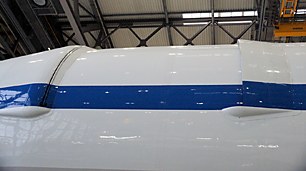Why does SOFIA have a bulge?

You could say that SOFIA is the aircraft equivalent of the hunchback of Notredame, as unlike its elegant colleagues that we know and appreciate from normal air transport, our observatory has a hunch, or a bulge. Does that make SOFIA unattractive? Perhaps! But I believe that it is the bulge that makes the aircraft so interesting, as it hides SOFIA’s inner treasure: the telescope, the star trackers and last but not least the door system as well – with all the integral components.

Taking a flight on board this aircraft is really special: we intentionally and routinely open the door during the flight. This is of course strictly forbidden on ‘normal’ flights – and for good reason. But we are a flying observatory and require an unobstructed view of the sky. That is why we open the door, observe our astronomical targets and engage in fascinating science.

The bulge has two main purposes. First, it conceals the guiding rails for the door. Its second purpose is to lift the airflow during flight and to direct it away from the telescope opening. This reduces turbulence, which allows the telescope to remain stable and prevents us from producing unintentional sounds like an enormous flying flute. Without it, original simulation calculations determined that we would have emitted a quite impressive high-octave B.
When we want to make observations, the upper door is opened at around 35,000 feet (flight level 350 or FL350), so at an altitude of approximately 10,000 metres. This reveals the lower, panelled door. These panels ensure that the airflow at the back end of the telescope opening is raised and directed toward the control surfaces at the tail. The aircraft therefore remains under control and can be flown safely. Pilots also confirm that SOFIA flies and 'feels' just like a normal Boeing 747. And even the passengers in the cabin do not notice whether the door is opened or closed during the flight. Nothing rattles, and it does not get louder in the cabin. But they can tell when the door is open, as the previously black screen of the tracking cameras suddenly shows the starry skies.

It is clear that NASA did an outstanding job with its calculations and wind tunnel tests. As you can see, bulges can be pretty cool as well.
Tags:
